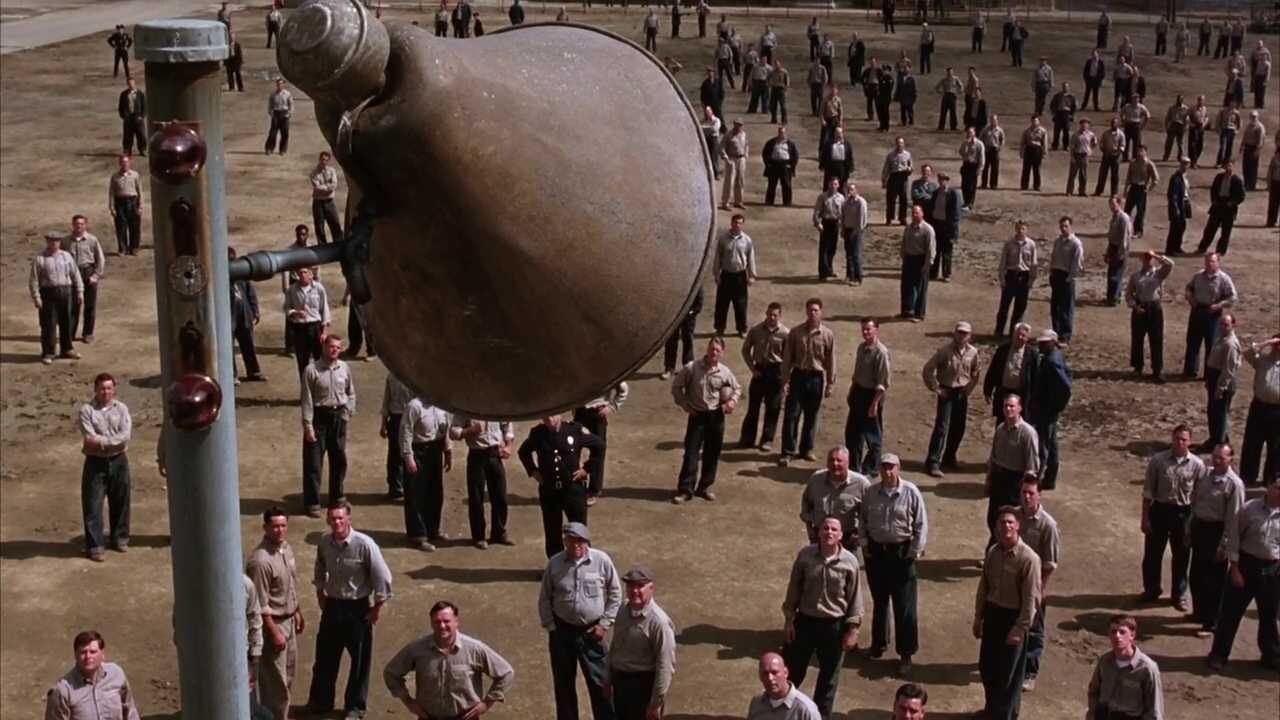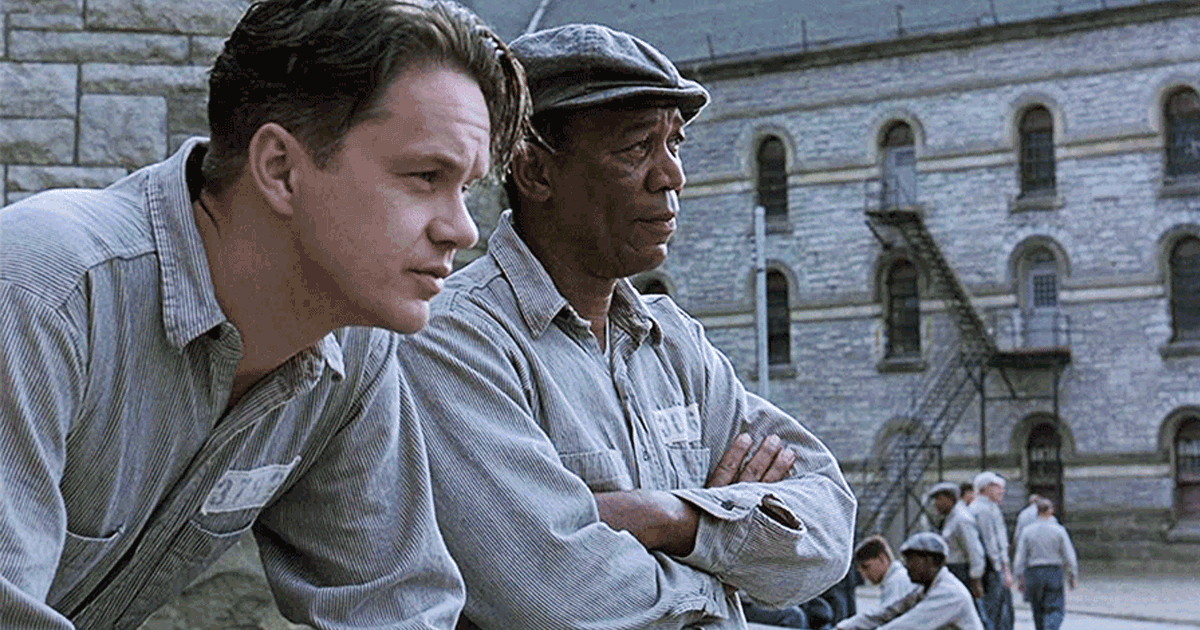The Shawshank Redemption | Directed by Frank Darabont // Starring Tim Robbins, Morgan Freeman, Bob Gunton, William Sadler, Clancy Brown, Gil Bellows, and James Whitmore
Set the mood with some music!
Summary (Spoiler-free): The Shawshank Redemption is a powerful and quietly profound drama about friendship, perseverance, and hope set against the bleak backdrop of a maximum-security prison. It follows Andy Dufresne, a soft-spoken banker sentenced to life for a crime he insists he didn’t commit, and his evolving bond with longtime inmate Ellis "Red" Redding.
Let’s just get this out of the way: every dude with a Netflix account and a college poster collection has The Shawshank Redemption in their top five movies of all time. Usually right next to Fight Club and The Dark Knight (hello, irony, it's me, Jim). And why? Because they caught it on TNT one random Sunday and got completely pulled in. And here’s the thing... they’re absolutely right.
Shawshank isn’t just a bro classic. It’s one of the most perfectly constructed, emotionally resonant, and quietly powerful films ever made. It’s the kind of movie that reminds you why storytelling matters — and how deeply it can move you when done right.
For all the praise Shawshank gets for its themes and narration (and we’ll get there), the acting is the beating heart of this movie — and it’s flawless.
Tim Robbins gives a masterclass in restraint as Andy Dufresne. His performance isn’t showy, but that’s exactly what makes it so brilliant. There’s this quiet intensity in how he carries the character — a man who seems passive on the surface, but whose resolve runs so deep it practically shapes the story around him. Every look, every pause, every barely-raised eyebrow carries weight. You believe he’s thought three steps ahead.
And then there’s Morgan Freeman. It’s hard to even talk about Freeman’s Red without just sounding like a greatest hits album of “incredible performance” clichés. But the truth is, he’s that good. There’s a reason his narration became the gold standard for movie voice-overs. It’s rich, world-weary, wise, and somehow comforting even when he’s talking about soul-crushing prison life. His chemistry with Robbins is so natural that you forget you’re watching a movie. You just believe in their friendship.
The supporting cast is stacked, too. Clancy Brown as the terrifying guard Hadley, Bob Gunton as the icy Warden Norton, and James Whitmore as Brooks, who gets one of the most quietly devastating arcs in film history. Everyone brings it. There’s not a false note in the entire ensemble.
Frank Darabont’s direction is like the story itself: quiet, deliberate, and deceptively powerful. There’s nothing flashy here. No sweeping camera moves, no over-stylized edits, no "look at me" moments. And that’s exactly why it works. Darabont understands the story he’s telling — one of endurance, slow transformation, and quiet rebellion — and he directs with a kind of invisible confidence that lets the characters and writing breathe.
One of the smartest things he does is give the film room to feel. He lingers on silences. He lets the camera sit on faces. He allows a scene to unfold naturally, trusting that the emotional payoff doesn’t need to be rushed. The movie isn’t afraid of stillness, which is something so many modern films could learn from. There’s a discipline to how it’s shot — a sense of containment that reflects the claustrophobia of prison life, without ever making the audience feel trapped.

And when Darabont does go for a big visual moment, it hits that much harder. The wide shot of Andy standing in the rain? Iconic. The slow zooms through the prison yard? Poetic. These moments stick because they aren’t overused. They feel like emotional release valves after long stretches of subtle tension.
Darabont was a relatively new director at the time, and the fact that this was essentially his directorial debut still kind of blows my mind. He directs with the grace and patience of someone who’s been doing this forever. It’s not just good direction — it’s direction that fully disappears into the story. And that, ironically, is what makes it so great.
At its core, The Shawshank Redemption is a story about hope, but not the fluffy, inspirational poster kind. This is hope that’s hard-won, chipped out of stone with a spoon over decades. It’s about dignity in the face of despair, about patience as a form of rebellion, and about the quiet resistance of holding onto your sense of self when everything around you is trying to strip it away.
What makes the story so remarkable is how simple it is. There’s no high-concept gimmick here. It’s a slow burn, a character study, a prison drama that unfolds like a fable. And yet, somehow, it’s gripping from beginning to end. That’s because Shawshank understands something a lot of movies forget: a great story doesn’t need to be loud — it just needs to mean something. Every beat feels purposeful. Every emotional payoff has been earned. And there’s a deep satisfaction in watching all the quiet setup bloom into something powerful by the final act.

The brilliance is in the details. A rock hammer. A poster. A library. Small things that seem mundane at first but take on immense weight over time. And as you watch Andy Dufresne’s journey unfold, you realize you’re not just following his story — you’re internalizing his mindset. His calm. His refusal to let the system break him. Red might be the narrator, but Andy is the heartbeat of the story, and his arc from passive inmate to quiet revolutionary is one of the most rewarding in cinema.
And again, this isn’t a story that needs to shock you. The beauty of the film, especially the ending, isn’t in some jaw-dropping twist reveal. It’s a story that earns your trust and then pays it off in full. It builds its power slowly, deliberately, one brick at a time. By the time you reach the end, you feel like you’ve been through something. Not just watched it — but lived it.
The pieces have been quietly laid out for you. The movie trusts you to notice them, or not. And even if you do see it coming, it doesn’t make it any less satisfying. In fact, it probably makes it better. Because Shawshank isn’t about surprising you — it’s about giving you something rare: emotional catharsis that feels honest.
The final scenes land not because of what happens, but because of how much you care by the time it does.
The Shawshank Redemption is one of those rare movies that gets better every time you watch it. It doesn’t rely on flashy visuals, massive stakes, or twisty gimmicks. It’s not a movie that demands your attention with loud spectacle. It earns it with character, writing, and emotion.
Frank Darabont’s direction is understated but elegant. The cinematography by Roger Deakins (yes, that Roger Deakins) captures both the cold brutality of prison life and the fleeting, hard-earned moments of hope. Thomas Newman’s score doesn’t scream for attention but rather gently pulls you through the emotional current of the film.
But at the end of the day, it’s the acting that elevates Shawshank to legendary status. Robbins and Freeman don’t just carry the movie — they embody it. Their performances are the lens through which we see despair, friendship, justice, and redemption.
Yes, it’s the bro pick. Yes, everyone and their uncle claims this is the best movie ever made. But sometimes, the crowd is right.
The Shawshank Redemption doesn’t just live up to the hype — it defines it.